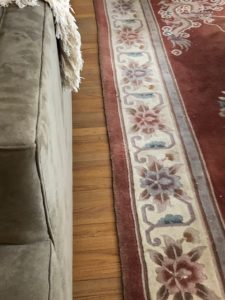 Winter in Chicago can be a drag.
Winter in Chicago can be a drag.
Even with the humidifier running at high saturation, my nose, throat, and skin are painfully dry, dry, dry.
No farmers markets. No pony league baseball watching in the parks. If masking up to go to the store has presented a motivation challenge, navigating around patches of ice has made decisions about going out easy. I just don’t want to.
Apparently, neither does my dog, India.
Normally eager to go out for a walk, lately, she moves like she’s in no hurry. Whether waking from napping in the living room or in our bedroom (she leads a hard life, for sure), during January, she no longer rushes to the front door of my apartment and waits while I make sure I have plastic bags in my pockets.
She’ll look at me quizzically, as if posing the rhetorically obvious by the angle of her snout. “You’re not going to make me go out there, are you?”
I can’t exactly explain to her why we have to go outside despite the frigid temperatures. I think she understands. I have given thought to how to make this necessary outdoor excursion as short and easy for both of us as possible.
This idea came to me a few years ago when we were visited by a weather phenomenon the TV weathermen referred to as the Polar Vortex.
They repeatedly mentioned how temperatures around zero, with windchill indexes in the minus zero zone, meant that pets should not be outside for more than five minutes.
Knowing that India primarily sees walks outside as bonding time and a chance to eat discarded fast food wrappers, the idea of going outside to “lighten up” is secondary. It’s proven to be hard on occasion to keep walks short even when the environment is not friendly.
So, I decided we would walk indoors before we ventured outside. Then, she’d more likely be ready to get to business within a few steps of the building’s front door.
I’ll suit up first. Already dressed in layers, I’ll wiggle my arms into the sleeves of my jacket, then close both inner and outer zippers. I’ll lace up my water-proof boots and hover over my furry sidekick.
I’ll put her pink reversible fleece jacket on, threading the metal loops from her harness through the slit just below her neck and attach her leash. Then I’d rub a natural balm on her paw pads to minimize the effects of salt.
Then…one…two…three times…I’ll lead her around the back of my couch in a counter-clockwise direction. She’ll hesitate when I coax her through the narrow path between the wine rack and my end table.
After one rotation past the fireplace and around my couch, she’ll look at me, ready to head to the door.
But no. I’ve decided that three rotations around the couch yields the best result. It gives us the best assurance that our time in the cold will be short.
She’ll be slow on the leash (she hates going over territory she has already sniffed thoroughly when we’re outside too), but she doesn’t put up too much of a fight.
I think she has come to expect that when the temperature goes below twenty, when I dress her in her jacket, she should expect a pre-walk walk. I wonder if she knows that I do this for both of us.
I thought about how everyone can turn a routine into a ritual. Attaching meaning to an action totally changes the feeling involved in performing the action.
When we click on our seat belts, we can think about, potentially, saving a life.
When we have tea or coffee in the morning, we can think about starting our day doing something exactly the way we like; maybe having tea with honey or Splenda or coffee with frothed milk or simply black.
When we clean our bathroom on the weekends, we can think about making it a welcoming sanctuary for short breaks — for alone time or thinking time or even magazine reading — during the week.
Attaching meaning to even the simplest activity can change your experience a lot.
Turning a routine into a ritual is no small thing.



India looks very smart in her hot pink coat